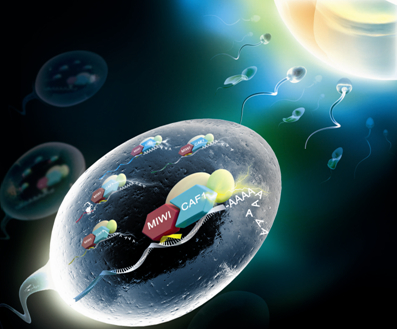
Massive Degradation of mRNAs in Late Spermatids Mediated by Pachytene piRNAs and pi-RISC Complexes
May 08, 2014 Email"> PrintText Size

Unlike oocytes, which contain abundant maternal mRNAs and proteins to support early embryogenesis, sperms possess little mRNAs and are believed to only donate their genetic information that remains silent until zygotic activation. It has remained elusive how the large variety of mRNAs in late spermatids are purged during spermiogenesis. Spermatogenesis in mammals is characterized by two waves of piRNA expression: one corresponds to classic piRNAs responsible for silencing retrotransponsons and the second wave is predominantly derived from nontransposon intergenic regions in pachytene spermatocytes, but the function of these pachytene piRNAs is largely unknown.
Under the supervision of Prof. LIU Mofang at the Institute of Biochemistry and Cell Biology, Shanghai Institutes for Biological Sciences, GOU Lantao, DAI Peng and their colleagues, in collaboration with Dr. YANG Jianhua from Sun Yat-sen University, demonstrate that pachytene piRNAs are assembled with their binding protein MIWI and deadenyalse CAF1 to form a piRNA-induced silencing complex (pi-RISC), promoting deadenylation and decay of their targets through imperfectly base-pairing with the target mRNAs. Furthermore, pi-RISC is assembled in elongating spermatids and mediates the degradation of thousands of mRNAs in this late stage of spermatid development.
Their study uncovers a male germ cell-specific mRNA degradation program that utilizes the enormous repertoire of targeting capacity of piRNAs, and documents a key function of pachytene piRNAs in development.
This study entitled “Pachytene piRNAs instruct massive mRNA elimination during late spermiogenesis” was published online in Cell Research on May 2, 2014.
This work was done in collaboration with Drs. QU Lianghu, FU Xiangdong, WANG Enduo, WU Ligang, LI Yong and SHI Huijuan, and supported by grants from the Chinese Academy of Sciences, the Ministry of Science and Technology, National Natural Science Foundation of China, and the Science and Technology Commission of Shanghai Municipality.

A model for massive elimination of mRNAs by pi-RISC in late stages of spermiogenesis. (Image by Dr. LIU Mofang’s group)
CONTACT:
LIU Mofang, Principle Investigator
Institute of Biochemistry and Cell Biology, Shanghai Institutes for Biological Sciences, Chinese Academy of Sciences
Shanghai 200031, China
Phone: 86-21-54921146
E-mail: mfliu@sibcb.ac.cn
Unlike oocytes, which contain abundant maternal mRNAs and proteins to support early embryogenesis, sperms possess little mRNAs and are believed to only donate their genetic information that remains silent until zygotic activation. It has remained elusive how the large variety of mRNAs in late spermatids are purged during spermiogenesis. Spermatogenesis in mammals is characterized by two waves of piRNA expression: one corresponds to classic piRNAs responsible for silencing retrotransponsons and the second wave is predominantly derived from nontransposon intergenic regions in pachytene spermatocytes, but the function of these pachytene piRNAs is largely unknown.
Under the supervision of Prof. LIU Mofang at the Institute of Biochemistry and Cell Biology, Shanghai Institutes for Biological Sciences, GOU Lantao, DAI Peng and their colleagues, in collaboration with Dr. YANG Jianhua from Sun Yat-sen University, demonstrate that pachytene piRNAs are assembled with their binding protein MIWI and deadenyalse CAF1 to form a piRNA-induced silencing complex (pi-RISC), promoting deadenylation and decay of their targets through imperfectly base-pairing with the target mRNAs. Furthermore, pi-RISC is assembled in elongating spermatids and mediates the degradation of thousands of mRNAs in this late stage of spermatid development.
Their study uncovers a male germ cell-specific mRNA degradation program that utilizes the enormous repertoire of targeting capacity of piRNAs, and documents a key function of pachytene piRNAs in development.
This study entitled “Pachytene piRNAs instruct massive mRNA elimination during late spermiogenesis” was published online in Cell Research on May 2, 2014.
This work was done in collaboration with Drs. QU Lianghu, FU Xiangdong, WANG Enduo, WU Ligang, LI Yong and SHI Huijuan, and supported by grants from the Chinese Academy of Sciences, the Ministry of Science and Technology, National Natural Science Foundation of China, and the Science and Technology Commission of Shanghai Municipality.

A model for massive elimination of mRNAs by pi-RISC in late stages of spermiogenesis. (Image by Dr. LIU Mofang’s group)
CONTACT:
LIU Mofang, Principle Investigator
Institute of Biochemistry and Cell Biology, Shanghai Institutes for Biological Sciences, Chinese Academy of Sciences
Shanghai 200031, China
Phone: 86-21-54921146
E-mail: mfliu@sibcb.ac.cn
CAS Institutes
There are 124 Institutions directly under the CAS by the end of 2012, with 104 research institutes, five universities & supporting organizations, 12 management organizations that consist of the headquarters and branches, and three other units. Moreover, there are 25 legal entities affiliated and 22 CAS invested holding enterprisesThere are 124 I...>> more
Contact Us

Chinese Academy of Sciences
Add: 52 Sanlihe Rd., Xicheng District, Beijing, China
Postcode: 100864
Tel: 86-10-68597592 (day) 86-10-68597289 (night)
Fax: 86-10-68511095 (day) 86-10-68512458 (night)
E-mail: cas_en@cas.cn

